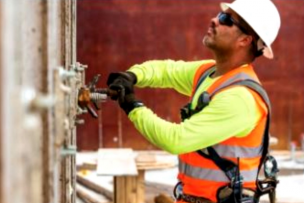From a clean environment to the right protective gear, here are 5 things to address before (and during) verifying voltage absence to stay out of harm’s way.
For experienced electrical technicians, moving through a safety checklist quickly—even skipping or combining a few steps––can mean finishing faster. But while those extra 5 or 10 minutes gained can mean time saved for the next job, you could be paying for that swiftness with your life.
That frightening reality especially rings true when it comes to voltage absence verification during the lockout/tagout process at voltages of 50 or more. Your bare hands (minus the protection of rubber protective gloves) could come into contact with the once-energized components, putting you at extreme risk for electrocution. If a digital multimeter (DMM) fails to operate properly, your life could end instantly.
Scary electrocution scenarios aside, these types of accidents are more than preventable––with the right procedural testing steps. From assessing your environment to wearing the proper protective gear, here are five electrical safety questions to answer prior to (and during) voltage absence verification testing.
1. Is your environment safe?
You wouldn’t work in your home garage with your children running in the yard and sharp tools scattered in harm’s way. So why would you subject yourself (and your colleagues) to dangers in an unsafe testing environment at work?
Before beginning the verification process, take a complete scan of your environment and address the following:
- How do you plan to use your meter?
- Where will you mount it?
- Do you have clear access to the equipment in question?
- Have you been trained on or are you knowledgeable in the use of the meter?
- Are environmental hazards present, such as tree branches or water?
Although tree limbs and accessibility can create obstacles during testing, the most crucial factor is lighting. You should be able to clearly see the point of measurement at all times. If you have to work in full or partial darkness, turn on the tool’s backlight or use the test probe extender and probe light to illuminate the area.
2. Are you wearing the right personal protective equipment?
Let’s be clear here: When you’re working with voltage absence verification, you’re not dealing with slight shocks. Often, these flashes can spur serious injury or death, both of which can only be defended by a single type of wear: personal protective equipment, or PPE, which includes eye and hearing protection, insulated hand tools, insulated gloves and fire-resistant clothing.
3. Does the DMM work properly?
Congratulations. If your work environment is free of dangerous obstructions and you’re wearing PPE items, half of the safety battle has already been won. Of course, next will come the actual testing portion of the DMM––which will require your complete and total concentration and care.
While verifying that the DMM works properly, ensure the function switch is placed to “voltage.” You’ll want to do this before checking the reading on the meter face.
4. Does the circuit pass inspection?
After verifying that the DMM is working, you’ll need to ensure the circuit passes inspection. Be sure to measure phase-to-phase and phase-to-ground across all phases. Always be sure that zero energy is being indicated on the circuit.
5. Does the DMM still indicate voltage?
Last but not least, you’ll need to check that the DMM still properly reads voltage measurements. This can be done by placing the test probes on a known energized source and observing the reading on the meter face. Unsure how up to par your digital multimeter safety I.Q. is? Get more details from electrical test experts Fluke to find out.
Taking Action and Ownership
Although checks and balances across the team play a crucial role in keeping everyone safe when verifying the absence of voltage, the primary responsibility for safety comes down to the individual. Whether you’re in the field or helping out another technician on the job, wearing the appropriate PPE, assessing the workspace environment and performing all testing thoroughly will save everyone from injury.
Yes, testing takes time. But these necessary steps also mean going home safely to your family at the end of each day.
CLICK HERE to explore product solutions that help maintain a safer workplace while working with electricity.





Talk to Us!
Leave a reply
Your email address will not be published. Required fields are marked *